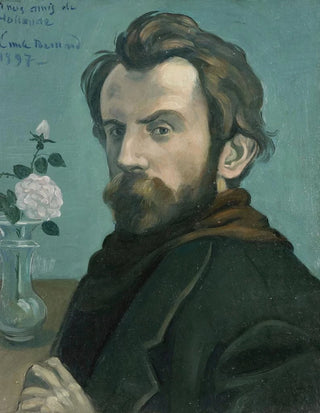Painting Self-portrait - Émile Bernard | Art print


View from behind

Frame (optional)
Émile Bernard's self-portrait, a hallmark of late 19th-century art, embodies the very essence of the quest for identity through the lens of art. This painting, vibrant with colors and emotions, immerses us in the artist's inner universe, revealing his thoughts, aspirations, and worldview. Bernard, a central figure of the post-impressionist movement, manages to capture the complexity of the human soul while playing with shades of light and shadow. The art print of this work allows us to rediscover not only the undeniable talent of the artist but also the era in which he evolved—a period rich in artistic innovations and cultural upheavals.
Style and uniqueness of the work
Émile Bernard's self-portrait stands out for its bold approach and refined technique. The artist, using vivid colors and stylized forms, creates an atmosphere that is both intimate and universal. The brushstrokes, precise yet free, demonstrate a technical mastery that transcends simple representation. Bernard plays with contrasts, using complementary hues to highlight the features of his face while evoking psychological depth. The composition, centered on the artist himself, invites the viewer to delve into his thoughts, to feel the intensity of his gaze, and to reflect on the notion of identity. This painting, far from being a mere self-portrait, becomes a reflection on art and its capacity to express the inexpressible.
The artist and his influence
Émile Bernard, born in 1868 in Lille, is often regarded as a pioneer of post-impressionism. His work, marked by a constant search for new forms of expression, influenced many contemporary artists. Bernard surrounded himself with iconic figures such as Paul Gauguin and Vincent van Gogh, with whom he shared innovative ideas on color and composition. His style, blending Japanese influences and symbolism, paved the way for new artistic explorations, making him a key player in the evolution of modern art. Through his self-portraits, Bernard does not merely depict his image, but

Matte finish

View from behind

Frame (optional)
Émile Bernard's self-portrait, a hallmark of late 19th-century art, embodies the very essence of the quest for identity through the lens of art. This painting, vibrant with colors and emotions, immerses us in the artist's inner universe, revealing his thoughts, aspirations, and worldview. Bernard, a central figure of the post-impressionist movement, manages to capture the complexity of the human soul while playing with shades of light and shadow. The art print of this work allows us to rediscover not only the undeniable talent of the artist but also the era in which he evolved—a period rich in artistic innovations and cultural upheavals.
Style and uniqueness of the work
Émile Bernard's self-portrait stands out for its bold approach and refined technique. The artist, using vivid colors and stylized forms, creates an atmosphere that is both intimate and universal. The brushstrokes, precise yet free, demonstrate a technical mastery that transcends simple representation. Bernard plays with contrasts, using complementary hues to highlight the features of his face while evoking psychological depth. The composition, centered on the artist himself, invites the viewer to delve into his thoughts, to feel the intensity of his gaze, and to reflect on the notion of identity. This painting, far from being a mere self-portrait, becomes a reflection on art and its capacity to express the inexpressible.
The artist and his influence
Émile Bernard, born in 1868 in Lille, is often regarded as a pioneer of post-impressionism. His work, marked by a constant search for new forms of expression, influenced many contemporary artists. Bernard surrounded himself with iconic figures such as Paul Gauguin and Vincent van Gogh, with whom he shared innovative ideas on color and composition. His style, blending Japanese influences and symbolism, paved the way for new artistic explorations, making him a key player in the evolution of modern art. Through his self-portraits, Bernard does not merely depict his image, but
12,34 €






